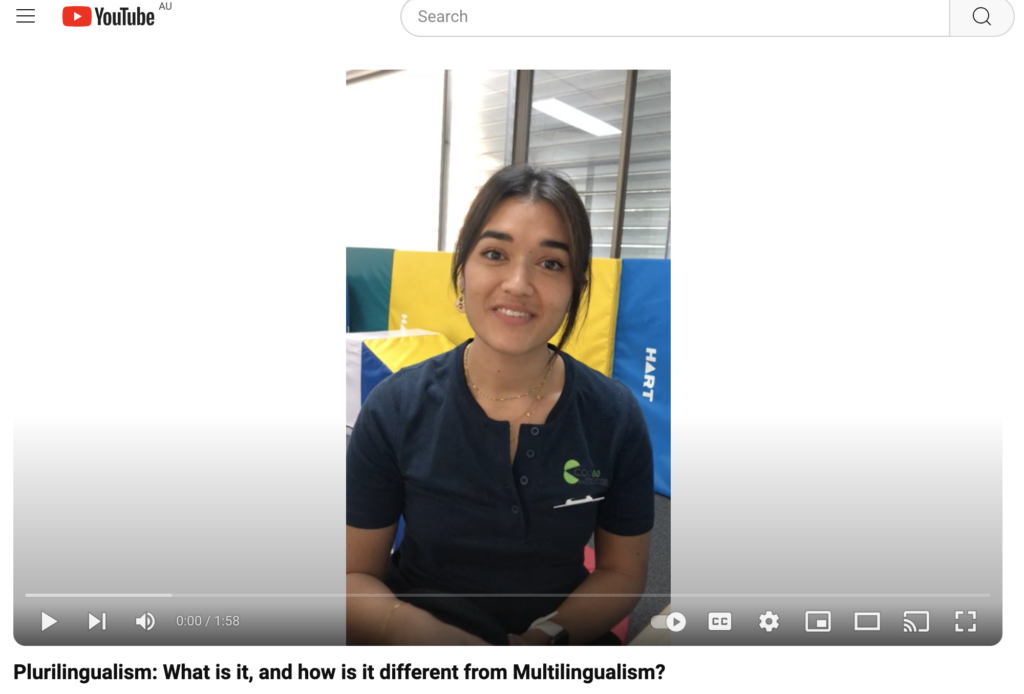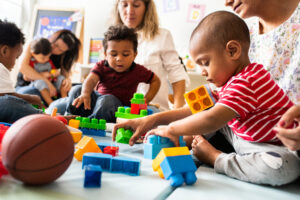What is Plurilingualism?

As a Speech Pathologist, when I first read the word ‘Plurilingualism’ I was very curious. At first, I thought it was just another word for ‘Multilingualism’ or multilingual language development. But after reading more about it, I learned that plurilingual and multilingual are different – and that a plurilingual approach to language development is very important and empowering for children who are growing up with many languages and cultures around them.

So… What is Plurilingualism?
Plurilingualism is when a person can switch or change between speaking different languages, when they are talking with people – so that their intended message can be most clearly understood.
This can look like:
- A child listening to their parent speaking in one language, and then replying in a different language
- An older child talking to their friend on the phone in English, and then turning around to ask their mother a question in their native language
Plurilingualism is about combining and using all of the different languages and cultures a person has, and switching between them when the situation needs them to, so that they have the best communication success – and research shows that people who follow a ‘plurilingual’ approach have:
- Better thinking and reasoning skills – to help them problem solve and plan how to communicate with different people
- More creativity – thinking of new and different ideas
- Better language self-awareness – thinking about the language they use when talking and writing for different reasons, and monitoring their language to check that it is clear and understood by others
(Psaltou-Joycey, et al., 2009)
How is this different from Multilingualism or multilingual communication?

I found this tricky at first too. But there is a difference!
Plurilingualism is all about changing between and using the many languages you know based on the context – this means that a person will change the language they are speaking with depending on who they are talking to, how confident they are with wording, and the words/vocabulary they know in the language.
Whereas Multilingualism is about knowing more than 1 language, and developing each language so that the person is proficient in every language they have.
If a family was using a ‘multilingual’ approach to developing their child’s language, they might speak English for certain tasks in the day and then use their home languages for other tasks in the day → so that overall the child has lots of exposure to all the languages. The point of this is to help all of the child’s languages grow, so they can fluently communicate and understand everything in all of their languages.

But! If a family was using a ‘plurilingual’ approach, they might keep talking to the child in the language they feel most comfortable or confident in for that task – this might mean that they change between all of their languages in 1 activity.
This could look like:
- Reading a book in the native language, and using English words and sentences for the parts that aren’t able to be directly translated
- Doing ‘role play’ and pretending to play ‘going shopping’ while using English, and then using native language sentences to comment on the other things you need to do after the shops
Won’t this confuse the child?

In my opinion as a Speech Pathologist, I don’t believe it will because the research doesn’t support this.
The research shows that ‘quantity’ is much more important for language development, rather than quality – this means that the more a child hears and practises a language the faster it will develop, regardless of how ‘perfect’ it sounds (Verhagen et al., 2022).
Research also shows that children best develop language when they are using it in a meaningful and motivating context (Feldman, H., 2019).
So, if the child is hearing and practising using different languages in situations that are important for the child (such as wanting to use English to talk to the other children at daycare, or wanting to use Hindi to talk to their cousins), they will be developing their language skills faster.
The adults using their most comfortable language will also mean that the adult can focus more of their attention on being present with the child and playing/talking with them more freely, which will help the conversation feel more enjoyable for the child.
The goal of Plurilingualism is simple – communication success in every situation.
And as a Speech Pathologist, this is what I want too – for every child I support to communicate successfully in every moment and situation.
So I recommend using a plurilingual approach and combining your languages and cultures together to show the child how all of their worlds and languages can work together.

Thida Hantun
Certified Practising Speech Pathologist
References:
Byers-Heinlein, K., & Lew-Williams, C. (2013). Bilingualism in the Early Years: What the Science Says. LEARNing landscapes, 7(1), 95–112.
Feldman, H. (2019). How young children learn language and speech: Implications of theory and evidence for clinical pediatric practice. Pediatrics in Review, 40(8): 398–411. doi:10.1542/pir.2017-0325.
Psaltou-Joycey, A., & Kantaridou, Z. (2009). Plurilingualism, language learning strategy use and learning style preferences. International Journal of Multilingualism. 6 (4): 460–474. doi:10.1080/14790710903254620
Verhagen, J., Kuiken, F., & Andringa, S. (2022). Family language patterns in bilingual families and relationships with children’s language outcomes. Applied Psycholinguistics, 43(5):1109-1139. doi:10.1017/S0142716422000297
